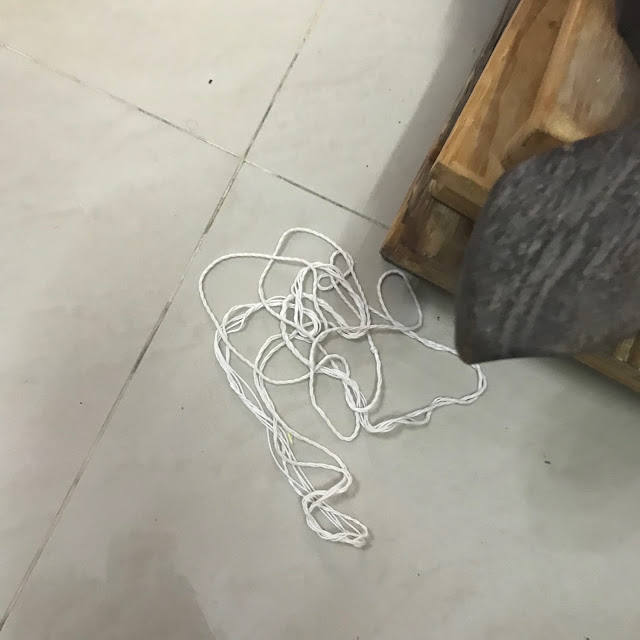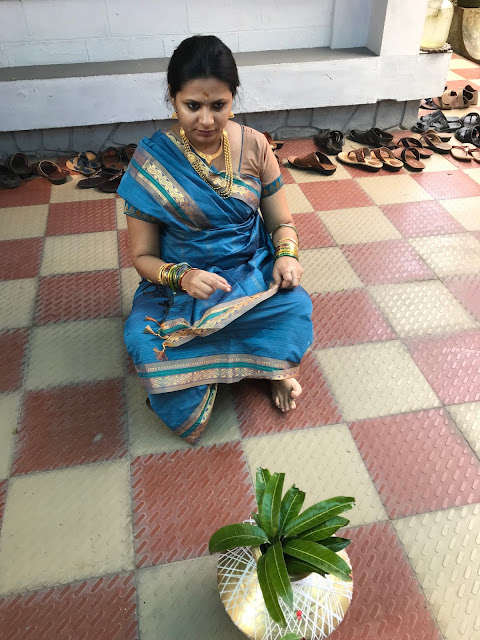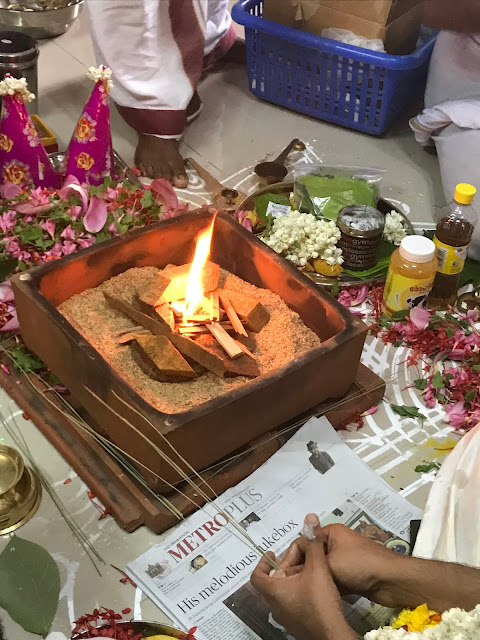Valai kappu, Seemantham & Pumsuvanam / Iyer Baby Shower
Post Marriage, when a woman gets pregnant for the first time, we conduct a pooja (prayer service) for her and the baby in her womb. We call upon all the Gods to help her deliver the baby easily and both the mother and child lead healthy lives. We pray that the unborn foetus is blessed and is born will no handicaps and it grows up into a good human and leads a long healthy life doing the duties as prescribed in our ancient texts.
The first child is called Seemantha Puthran. Puthran is the person who helps your soul get across the river ‘puth’ while it travels through the nether world. This is the person who speaks the Lord’s name into our dead / dying body. The last sense organ to leave the physical body is hearing.
As generations went by and girls got married away & boys stayed back; the author thinks Puthran became synonymous with Son. Seemantha puthran, thus became male child.
Let us, in the beginning, absolve our Great Rishis who formulated the beautiful system for the welfare of the newly pregnant woman and her unborn baby and not make them the scapegoats of the interpretations of their future generations.
Praying for a puthran or son, does not mean a girl child is not welcome. My maternal grandmother used to say, "Thalachan Ponna pethuppa chamathy". Translation: A wise woman will deliver first a girl child.
Now that the issue of gender (which is a real sore issue!) has been taken care of, let us move to the functions.
Please remember the author is just DOCUMENTING the Seemantham!
Recently, we conducted the Seemantham of my cousin brother's wife - Sri Lakshmi (lovingly called Deepu). She was to start her 7th month soon and a date was chosen by the vadhyar (priest) before that. This function is done either in the 6th month or 8th month. Either way, after this function the girl is carted off to her maternal home by her parents and would return to her husband only 3 - 6 months after delivery.
As usual the functions started early in the morning. As I live in the same town, I did not stay overnight and by the time I reached much of the work was done.
Mavilai thoranam (string of mango leaves) welcomed me.
First guest had arrived.
The kolam had dried.
The dining table had found it's way to the pooja room! Dining room would be the venue of the ceremony.
Two 'kutties' (laddoos or any sweet shaped as a cone and covered with beautiful paper) had been placed at the place of pooja. As were other sweets and flowers and ...
BANGLES!!
And the would-be-mother was dressed in our traditional wear - pudavai.
This is Siva and Deepu. It was her Seemantham.
But first is the 'valai-kaapu'.
It starts with them seeking the blessings of elders, by falling at their feet.
This is her grandmother, who has travelled all the way from Thiruvananthapuram.
Next all the elders (including me) bless them.
The pregnant woman is made to sit and then we start loading her.....with bangles.
Lots of bangles.
Her mother and mother-in-law sit on either side and start off the function. Starting with a bangle made with neem stem, then silver, then gold...followed by lots of glass bangles..
Then all women join in and fill up her arms with colorful bangles...
Towards the end, the would-be-mother makes a child sit on her lap and adorns him with bangles.
Her husband also gets a chance!
A final count of the bangles is done. Right hand must have odd number bangles, and left hand even.
Every function ends with aarathy. A red thin watery mixture made by mixing turmeric and lime is swirled. Ladies from either branches of the family (with the same position - uncle's wife, father's sister or mother's sister...) remove the ill-effects / evil eyes with this.
You will find this repeated many times through out the function.
All ladies got to wear the lovely glass bangles too. Look I too wore bangles which matched my sarree!
Kaaparisi is made for this and given to all.
But why do we make the pregnant woman wear so many bangles?
The baby in the stomach develops it's hearing sense at around 6 months. The cells inside it's developing head begin to arrange themselves into unique tissues that will eventually be the brain, face, eyes, ears and nose.
When the baby can hear the tinkling of the bangles, he/she knows that mother is near by. The sounds the baby gets used to 'in utero' will be less likely to startle it after it’s born. How great our forefather's were! They knew all this before the advent of modern science.
This is also the reason the mother is advised to keep chanting God's name often and have positive thoughts.
"When you are pregnant, the clearest noise your baby will be able to make out is yours. While most sound is transmitted through the air — and then through your uterus, when you speak, the sound of your voice reverberates through your bones and the rest of your body, amplifying it. Studies have shown that a fetus’s heart rate increases when she hears her mother’s voice, suggesting your baby becomes more alert when you speak. So reading out loud, carrying on conversations and singing the songs you’ll be repeating to your baby over the coming years will help her to get to know your voice." Says a site on pregnancy.
Indian women are never allowed to wear black color during any auspicious function. But this is one auspicious day, we are allowed to do so. This sarree is called - mashakka karuppu. "Mashakka" means yearning. And anything a pregnant woman yearns, must be fulfilled.
Post breakfast the main function starts.
Things the vadhyar needs get arranged around the kolam.
The Priest starts preparing the pot; in which the water to give the pregnant woman an abhishekham will be charged - with chants.
Meet Karthik Vadhyar of Edapally Grama Samooham, Ernakulam, Kerala.
My aunt lights the lamp to start the religious functions.
And the couple seek the blessings of all the elders.
The pooja starts. The would-be-father removes his old 'yagnopaveedham' aka Poonal and wears a new one.
First is always a pooja for Lord Ganapathy made with wet turmeric to remove all obstacles.
Time to exchange garlands.
"Ladies first", said the vadhyar!
Is it not lovely to see them in traditional attire? She is wearing 'podavai' / madisar and he is wearing the panchagajam and is smeared with three lines of wet viboothi / holy ash at strategic points called 'pattai' or Tripundra.
Now, starts the worship of the pot containing water.
45 minutes is spent by the priests to do Veda Japa. The would-be-father is advised to either join them or do the Gayatri japa.
Vadhyar uses this time to prepare the yellow thread to be tied around the mother's hands later.
After this japa is done, time for deeparadhana.
Now that the water is charged, this is sprinkled on all...
Rest of the positively charged water is used to give the mother a bath.
By the time she changes her wet clothes and comes back, the thread which was readied by the priest gets all the attention.
And another aunt smears red paste on their cheeks -pachai kazhikkal, as a mark of auspiciousness.
Now they were ready. He ties the thread around her left hand amid chants.
This is said to protect her and their child.
This marks the end of Seemantham.
Next is a function called - Pumsuvanam. This is done to beget a male child. This function is usually done at the end of first trimester and before the fourth month starts. But now a days, it is done along with Seemantham.
Seemantham is done only once in a woman's life - during her first pregnancy. But Pumsavanam can be done each time she gets pregnant.
Time for Pumsavanam.
Agni Deva or God of Fire has to be invoked.
Peral Mottu or the "buds of the great banyan tree" is ground in a pestle and mortar by a young girl or two, while she keeps saying - 'aan pillai' or boy child.
The girl(s) is/are given a small gift for the service!
The rest is ground by the priest.
This ground powder is tied to the end of a new sarree in a small pouch and immersed in milk. This milk is poured into the right nostril of the mother and is said to directly enter the uterus and help in making the fetus - male.
No one is allowed to see this being done and it is done with the help of the father's sister. In this case - ME!
The would-be-mother must wear this sarree after the rituals. There is a superstition that if another lady wears the same immediately, she too will be blessed with a child!
Next a line is drawn straight from her navel to her forehead - thrice, amid constant prayers and chants.
This pointed stick is a porcupine quill decorated with jasmine flowers and mango leaves.
Porcupine is one animal which cannot be easily killed, thanks to it's prickly exterior coat. The father prays for the well-being of his unborn child and hopes the god's will protect his baby as the porcupine is protected by the sharp quills.
One of my acquaintances on Facebook, Ruckmani Ananthanarayanan says, "Regarding porcupine quill , I wish to share what our vaadhyaar said during my seemantham, 5 years ago. He asked to draw a line with it from my navel to the center of my head. The naadi connecting to the cervix is supposed to be there it seems. He said a gentle prick has to be given so that it initiates the opening of the cervix gradually, enabling normal delivery..."
More flowers are placed on her head with a sprig of arungam pullu / karuka grass / bermuda grass. Even though rice stalk or wheat stalk would have easily passed the message of a fertile womb, these stalks are not to be adorned on one's hair. Bermuda grass is thus used. It is the favorite of Lord Ganesha. It has many medicinal properties.
This grass has the ability to grow in extreme climate conditions because of its extensive root system. It has a good tolerance capacity against insects and diseases. Bermuda grass can grow easily in poor soil as well and have the quality to recover quickly from damages such as cutting, fires etc. Because of its aggressive and persistent nature, Bermuda grass is very difficult to kill and eradicate.
The placing of this grass on the head by the sister-in-law is her (in this case, me) blessing the mother with 'vardhanai' and 'abivridhi' or growth of the family tree.
Now the function is drawing to a close and sweets are distributed to all.
The next ritual is special to people of the Sama-veda stream.
A vessel filled with cooked rice and topped with ghee is presented to the mother and she is questioned, "Kim pashyati?" or "What do you see?"
She then eulogises that; through this rice which will be consumed by her and her husband; she sees a bright future for them with many children to spread their fortunes further.
As sun is always the witness in these functions, they both walk out to see the bright sun and thank HIM for being a heavenly witness.
Look how he holds her hand?!
This is the way he held it for the first time, during their marriage.
Time for aashirvadam. Or getting the blessings of elders.
Turmeric stained rice is given to all elders and they bless the couple. He uses his anga-vastra or second cloth to collect these.
After the 'japam' is done, they do a final namasakaram.
Time for gifts!!
What is a baby shower without gifts?
First clothes.
Then....money and other auspicious things.
Now they give back - one banana and one coin each!
All the functions are considered completed, only when the aarathy gets taken. This time both the mothers do the honors.
And the 'man' blesses his 'wife'!
Time to thank the priests for having conducted the function.
The next function is called 'Appam Kozhakkattai kettal'.
This has no religious significance, but is another way of blessing the mother and child and also helping the mother-in-law pass on her request for many more grandchildren! Maybe also a gender-scan too?
For this the woman is made to wear a cloth around her waist like a kangaroo-pouch.
Into this is placed one banana, two betel leaves, one pakku and two each of appam and kozhakkattai.
These appam and kozhakkattai have to be finished that night by the husband and wife. So only 5 ladies take actual part in this ritual.
Once this pouch gets fastened to her waist, all the women take her aarathy. This aarathy is called - aethi erakkal. The women have to bend all the way down and then rise up with the lamp. Thus the name.
A lit lamp is placed on a bed of rice. A coconut is also held together with the lighted lamp while the aarathy is taken. Some households place the lighted lamp on top of the coconut. Precarious!
Traditionally, no pregnant woman is ever gifted a coconut. Coconut has 3 closed eyes these are supposed to be inauspicious and a harbinger of complicated birth.
After this function, the coconut is taken to the temple and broken.
Now the pregnant lady is made to stand with her hands extended.
Nine (9) coins are placed on her - one on her head, 2 on her shoulders, 2 on her palms, 2 at her waist and 2 on her feet.
When she does the namskaram, we all give her aashirvadam.
This aashirvadam is special.
All the women pat her on her back with hand full of neem leaf and turmeric stained rice dipped in sandal flavored milk. And they repeat 'aan pillai, pen pillai' meaning 'boy child , girl child'.
Time to guess the gender of the baby!
An unmarried child is made to pick from her pouch either an appam or kozhakkattai.
If the child pulls out an appam - girl child.
Kozhakkattai - Male child.
When the pouch is being removed by the girl's mother from the back, her mother-in-law stands in front to accept the same.....The mother-in-law then says," I will cook you many delicacies, just give me many grand children"! Link:https://youtu.be/Kp8DzZJqKaw
From this, one kozhakkattai is taken and placed in the would-be-mother's mouth.
Time for some fun!
We dance around her! This is called - kummi or edam chutti kali.
You can watch a video in which my father too joined us for a round with a song from his college days!
I have uploaded another (long) video. If you are interested in seeing our impromptu attempt at mohiniyattom, which is more the dance we must have done!
All the function finally get's over with a final aarathy of the would-be-mother.
Then it is time for a hearty LUNCH! Well-earned, I would say!
During lunch, the would-be-mother makes all the children available sit on her lap and gives them a morsel of rice mixed with ghee and dal (parippu chadom) placed on a poppadom; and also a banana.
Post Lunch, all the guests are sent away with some 'parting gifts'.
Off with the heavy clothes. Let's get comfortable!
P.S. - Baby is due January end, February beginning, 2018. The bangles will adorn her till she delivers her baby. Do pray for her and the baby.



















































































































Comments
I searched for the details because my best friends daughter's valakappu is nearing. Will definitely share this link with her for her.
Thanks once again. Even I am planning to write up various functions held in our tradition for the future generation.
Thanks once again.
Best regards
Raji Ramakrishnan.
was unable to watch the video. please check
best baby shower event planners in india
best baby shower event planners in hyderabad
Thanks for sharing this post with us.Wikivela
beautifully written!
fantastic reference for everyone of us who wishes to understand the significance of the function....almost like the "Meenakshi Ammal" book for recipies.
Congratulations and Thank you.